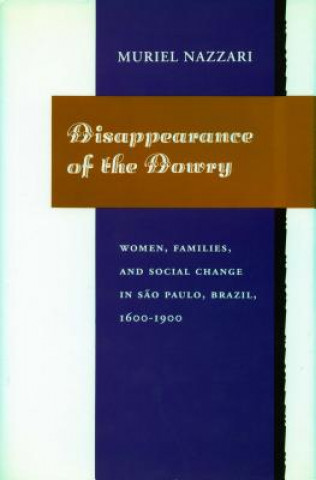
Code: 04716069
Disappearance of the Dowry
by Muriel Nazzari
Examining the practice of dowry in the city of Sao Paulo, Brazil, and its surroundings for nearly three centuries, this book locates patterns of change that explain the dowry's virtual disappearance by the beginning of the twentie ... more
- Language:
 English
English - Binding: Hardback
- Number of pages: 268
Publisher: Stanford University Press, 1991
- More about this

86.16 €

Low in stock at our supplier
Shipping in 13 - 16 days
Potřebujete více kusů?Máte-li zájem o více kusů, prověřte, prosím, nejprve dostupnost titulu na naši zákaznické podpoře.
Add to wishlist
You might also like
-

Discussions and More
64.77 € -18 % -

Murder, Mr Mosley
37.12 € -

Anthony Trollope y Analisis del Discurso
54.78 € -

Deep Learning in Healthcare
197.04 € -

Advances in Cognition, Education and Deafness
65.17 € -
![Collection of Poems in Six Volumes. by Several Hands. [Edited by Robert Dodsley.] Collection of Poems in Six Volumes. by Several Hands. [Edited by Robert Dodsley.]](https://media.libris.to/jacket/08000021t.jpg)
Collection of Poems in Six Volumes. by Several Hands. [Edited by Robert Dodsley.]
27.94 € -18 % -

Crop Circles, Jung, and the Reemergence of the Archetypal Feminine
18.15 € -21 % -

Cities of God
59.01 € -

Homeric Moments
26.63 € -

Extra 2%
21.28 € -21 % -

Helical Springs Made of Polymer Nanocomposite
34.30 € -9 % -

Acrylmalerei
17.14 € -14 % -

Ecotoxicology
406.40 € -

Circle to God
32.18 € -

Warszawa zburzona i odbudowana wer. Włoska
9.47 € -

Giro Cultural de la Traduccion
35.30 € -

All Mankind is One
18.56 € -19 % -

Cloister and the Hearth ... Second Edition.
26.32 € -19 % -

Reality or Fantasy?
65.67 € -

14 Ways to Accomplish Your Mission
13.01 € -19 % -

Journey Shared
11.49 € -18 %
Give this book as a present today
- Order book and choose Gift Order.
- We will send you book gift voucher at once. You can give it out to anyone.
- Book will be send to donee, nothing more to care about.
More about Disappearance of the Dowry
You get 216 loyalty points
 Book synopsis
Book synopsis
Examining the practice of dowry in the city of Sao Paulo, Brazil, and its surroundings for nearly three centuries, this book locates patterns of change that explain the dowry's virtual disappearance by the beginning of the twentieth century. In the seventeenth century, 91 percent of the sample of propertied families gave their daughters dowries; in the nineteenth century, only 27 percent of the families did so. Furthermore, of those families who still gave dowries in the nineteenth century, many gave a dowry to only one or two of several daughters. In the seventeenth century, daughters were favorer over sons, for they received dowries that were much larger than what their brothers would inherit later on. By the nineteenth century, parents were spending much money on their son's education while giving their daughters smaller dowries or no dowries at all. A seventeenth-century dowry included land, houses, cattle, and Indian and African slaves, so that the bride contributed most of the support of the newlyweds. By the end of the nineteenth century, the bride contributed little to the support of the married couple. As the practice of dowry declined and disappeared, it was accompanied by an ideological change. From viewing dowry as something that ensured their daughters' well-being, people came to see dowry as a way men sold themselves for easy money instead of supporting their families with hard work. Why did a practice that had been considered a duty stop being a duty? Why did property-owning families modify their behaviour regarding sons and daughters? And what were the consequences for the women of these families? Although the dowry declined and disappeared elsewhere - in most of Europe, in England, and in Mexico - this is the first book to study and document its disappearance. The author argues that the practice of dowry altered because of changes in society, the family, and marriage. Brazil changed from a hierarchical society in which status, family, and patron-client relations were primarily to a more individualistic society in which contract and the market increasingly reigned. The family changed from being the locus of both production and consumption to being principally the locus of consumption, while 'family' and 'business' became formally separated. m arriage was transformed from predominantly a property matter to an avowed 'love' relationship. At the same time, the strong authority of the patriarch over adult sons and daughters was greatly diminished.
 Book details
Book details
Book category Books in English Society & social sciences Society & culture: general Social groups
86.16 €
- Full title: Disappearance of the Dowry
- Subtitle: Women, Families, and Social Change in Sao Paulo, Brazil, 1600-1900
- Author: Muriel Nazzari
- Language:
 English
English - Binding: Hardback
- Number of pages: 268
- EAN: 9780804719285
- ISBN: 0804719284
- ID: 04716069
- Publisher: Stanford University Press
- Weight: 548 g
- Dimensions: 229 × 152 × 19 mm
- Date of publishing: 01. October 1991
Trending among others
-

Women Who Run with the Wolves
9.88 € -17 % -

Women Who Run With The Wolves
13.51 € -29 % -

Second Sex
15.12 € -23 % -

Lean In
12.80 € -23 % -

Why Does He Do That?
16.54 € -17 % -

The Way of Men
13.01 € -23 % -

Woman Looking at Men Looking at Women
12.20 € -27 % -

Autobiography of Malcolm X
10.18 € -23 % -

Nice Girls Don't Get The Corner Office
9.78 € -24 % -

Male Brain
12.40 € -21 % -

Black Elk Speaks
20.57 € -9 % -

Third Culture Kids
19.97 € -22 % -

Triumph of the City
10.99 € -25 % -

Politics of Reality
12.30 € -28 % -

Lost Keys of Freemasonry
9.78 € -19 % -

Sioux Chef's Indigenous Kitchen
30.36 € -14 % -

Winona Ryder
14.62 € -3 % -

Pillow Book of Sei Shonagon
9.07 € -18 % -

By Any Means Necessary
13.01 € -19 % -

Nice Girls Don't Get the Corner Office
14.82 € -26 % -

NATIVE AMERICAN MYTHS
18.25 € -28 % -

Secrets of Morals and Dogma by Albert Pike
7.96 € -28 % -

Dark Emu
15.23 € -28 % -

Maimonides-Essential Teachings on Jewish Faith & Ethics
16.13 € -19 % -

Between the Body and the Flesh
44.99 € -

Navajo Coyote Tales
16.13 € -19 % -

Queer X Design
21.88 € -21 % -

Manipulated Man
14.22 € -16 % -

Think Like a Monk
14.52 € -29 % -

The Mastery of Love
12.30 € -19 % -

Iron John
17.14 € -18 % -

The Velvet Rage
16.23 € -23 % -

Goddesses in Everywoman
12.20 € -22 % -

Who Cooked the Last Supper?
19.77 € -6 % -

The Autobiography of Malcolm X
10.48 € -7 % -

When God Was A Woman
19.66 € -2 % -

Gender Trouble
27.13 € -

Zami
10.08 € -24 % -

Letters to a Young Muslim
12.90 € -17 % -

Hillbilly Elegy
12.60 € -36 % -

Tom of Finland. The Complete Kake Comics
21.08 € -

Humans of New York
25.72 € -16 % -

Desert Flower
10.08 € -24 % -

Uncle Tom's Cabin
4.83 € -19 % -

Indigenous Peoples' History of the United States
15.43 € -15 % -

Raising Kanye
16.03 € -20 % -

Deepest Well
16.54 € -17 % -

Hillbilly Elegy
21.08 € -

Native American Clothing
55.58 € -14 %
Collection points Bratislava a 2642 dalších
Copyright ©2008-24 najlacnejsie-knihy.sk All rights reservedPrivacyCookies


 15549 collection points
15549 collection points Delivery 2.99 €
Delivery 2.99 € 02/210 210 99 (8-15.30h)
02/210 210 99 (8-15.30h)